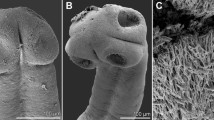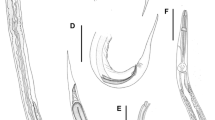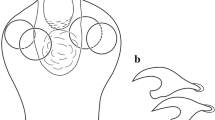Abstract
Ophiotaenia bungari n. sp. (Cestoda: Proteocephalidea) is described from the intestine of the banded krait Bungarus fasciatus (Schneider) (Ophidia: Elapidae) in Vietnam. The new species differs from all but three Ophiotaenia species parasitic in Asian reptiles in the possession of a glandular apical organ. It differs from O. andersoni Jensen, Schmidt & Kuntz, 1983 in the position of the vagina in relation to the cirrus-sac (anterior and posterior in O. bungari versus anterior only in the latter species), in the cirrus-sac/proglottis width ratio (29–38 versus 50%) and by having more testes (100–150 versus 42–116 in O. andersoni); from O. chattoraji Srivastava, 1980 in the number of uterine diverticula (50–65 versus 10–26) and in the cirrus-sac/proglottis width ratio (29–38 versus 22%); and from O. rhabdophidis (Burt, 1937) by having more uterine diverticula (50–65 versus 30–45), by the cirrus-sac/proglottis width ratio (29–38 versus 20–25%) and by the width of the scolex (360–420 versus 130–187 μm). The taxonomic importance of the relative size of the ovary (i.e. the ratio of the ovarian size in relation to that of the entire proglottis), a character previously not used in the systematics of proteocephalidean cestodes, is discussed. Comparison of measurements of all of the nominal species of Ophiotaenia La Rue, 1911 and Proteocephalus Weinland, 1858 (c.135 species) has shown that the ovary of species parasitic in snakes in the Americas, Africa, Asia and Australia is not only considerably smaller than that of congeneric species from European hosts, but also smaller than in all species of Proteocephalus parasitic in teleost fishes throughout the world.



Similar content being viewed by others
References
Ammann, M., & de Chambrier, A. (2008). Ophiotaenia gilberti sp. n. (Eucestoda: Proteocephalidea), a parasite of Thamnodynastes pallidus (Serpentes: Colubridae) from Paraguay. Revue Suisse de Zoologie, 115, 541–551.
Beddard, F. E. (1913). Contributions to the anatomy and systematic arrangement of the Cestoidea. VII. On six species of tapeworms from reptiles, belonging to the genus Ichthyotaenia (s. l.). Proceedings of the Zoological Society of London, 83, 4–36.
Binh, T. T., & Luc, P. V. (2005). Two cestode species parasitic in kraits (Bungarus fasciatus) in the Red river delta, Vietnam. Journal of Biology, 15, 45–47. (In Vietnamese; with English abstract).
Burt, D. R. R. (1937). Two new reptilian cestodes of the genus Proteocephalus (Ophiotaenia). Ceylon Journal of Science, 20, 157–179.
de Chambrier, A. (2001). A new tapeworm from the Amazon, Amazotaenia yvettae n. gen., n. sp., (Eucestoda: Proteocephalidea) from the siluriform fishes Brachyplatystoma filamentosum and B. vaillanti (Pimelodidae). Revue Suisse de Zoologie, 108, 303–316.
de Chambrier, A., Ammann, M., & Scholz, T. (2010). First species of Ophiotaenia (Cestoda: Proteocephalidea) from Madagascar: O. georgievi sp. n., a parasite of the endemic snake Leioheterodon geayi (Colubridae). Folia Parasitologica, 57, 197–205.
de Chambrier, A., Scholz, T., & Vaucher, C. (1996). Tapeworms (Cestoda: Proteocephalidea) of Hoplias malabaricus (Pisces: Characiformes, Erythrinidae) in Paraguay: description of Proteocephalus regoi n. sp. and redescription of Nomimoscolex matogrossensis. Folia Parasitologica, 43, 133–140.
de Chambrier, A., Zehnder, M. P., Vaucher, C., & Mariaux, J. (2004). The evolution of the Proteocephalidea (Platyhelminthes, Eucestoda) based on an enlarged molecular phylogeny, with comments on their uterine development. Systematic Parasitology, 57, 159–171.
de Chambrier, S., & de Chambrier, A. (2010). Two new genera and two new species of proteocephalidean tapeworms (Eucestoda) from reptiles and amphibians in Australia. Folia Parasitologica, 57, 263–279.
Freze, V. I. (1965). [Essentials of cestodology.] Vol. V. [Proteocephalata in fish, amphibians and reptiles.] Moscow: Nauka, 538 pp. (In Russian: English translation: Israel Program of Scientific Translation, Jerusalem, 1969, Cat. No. 1853, v + 597 pp.).
Fry, B. G., Wüster, W., Ramjan, S. F. R., Jackson, T., Martelli, P., & Kini, R. M. (2003). Analysis of Colubroidea snake venoms by liquid chromatography with mass spectrometry: evolutionary and toxinological implications. Mass Spectrometer, 17, 2047–2062.
Hypša, V., Škeříková, A., & Scholz, T. (2005). Multigene analysis and secondary structure characters in a reconstruction of phylogeny, evolution and host-parasite relationship of the order Proteocephalidea (Eucestoda). Parasitology, 130, 359–371.
Jensen, L. A., Schmidt, G. D., & Kuntz, R. E. (1983). A survey of cestodes from Borneo, Palawan and Taiwan, with special reference on three new species. Proceedings of the Helminthological Society of Washington, 50, 117–134.
Oros, M., Scholz, T., Hanzelová, V., & Mackiewicz, J. S. (2010). Scolex morphology of monozoic cestodes (Caryophyllidea) from the Palaearctic Region: a useful tool for species identification. Folia Parasitologica, 57, 37–46.
Schmidt, G. D. (1986). CRC handbook of tapeworm identification. Boca Raton, Florida: CRC Press, 675 pp.
Scholz, T., & Hanzelová, V. (1998). Tapeworms of the genus Proteocephalus Weinland, 1858: Proteocephalidae, parasites of fishes in Europe. Studie AV ČR, 1998 (No. 2), 119 pp.
Scholz, T., Hanzelová, V., Škeříková, A., Shimazu, T., & Rolbiecki, L. (2007). An annotated list of species of the Proteocephalus Weinland, 1858 aggregate sensu de Chambrier et al. (2004) (Cestoda: Proteocephalidea), parasites of freshwater fishes in the Palaearctic Region, their phylogenetic relationships and key to identification. Systematic Parasitology, 67, 139–156.
Spawls, S., & Branch, B. (1995). The dangerous snakes of Africa. Ralph Curtis Books. Dubai: Oriental Press, 192 pp.
Srivastava, V. C. (1980). Cestode fauna of reptiles of India part 1. Ophiotaenia chattoraji n. sp. (Cestoda: Ophiotaeniidae Freze,1963) from the cobra Naja tripudiens from Allahabad (India). Indian Journal of Helminthology, 22, 33–37.
Yamaguti, S. (1935). Studies on the helminth fauna of Japan. Part 7, Cestodes of mammals and snakes. Japanese Journal of Zoology, 6, 233–246.
Acknowledgements
The authors are deeply indebted to Drs Roman Kuchta and Miloslav Jirků, Institute of Parasitology, České Budějovice, for help during the collecting trip to Vietnam during October, 2010. Financial support of the Vietnamese Academy of Sciences, especially the Institute of Ecology and Biological Resources, is greatly appreciated. Thanks are also due to Janik Pralong, Florence Marteau and Gilles Roth (Natural History Museum, Geneva) and Martina Borovková, České Budějovice, for their technical help. This study was supported in part by the National Science Foundation PBI awards Nos. 0818696 and 0818823, the Institute of Parasitology (projects nos Z60220518 and LC 522) and the Grant Agency of the Czech Republic (524/08/0885).
Author information
Authors and Affiliations
Corresponding author
Rights and permissions
About this article
Cite this article
de Chambrier, A., Binh, T.T. & Scholz, T. Ophiotaenia bungari n. sp. (Cestoda), a parasite of Bungarus fasciatus (Schneider) (Ophidia: Elapidae) from Vietnam, with comments on relative ovarian size as a new and potentially useful diagnostic character for proteocephalidean tapeworms. Syst Parasitol 81, 39–50 (2012). https://doi.org/10.1007/s11230-011-9320-0
Received:
Accepted:
Published:
Issue Date:
DOI: https://doi.org/10.1007/s11230-011-9320-0




